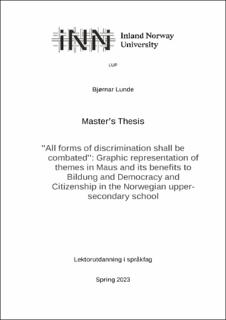“All forms of discrimination shall be combated”: Graphic representation of themes in Maus and its benefits to Bildung and Democracy and Citizenship in the Norwegian upper-secondary school
Abstract
Målet med denne oppgaven er å utforske den grafiske, multimodale representasjonen av temaer som etnisitet, brutalitet, traumer og historisk nøyaktighet i Art Spiegelmans Maus og dens fordeler for Bildung og demokrati og medborgerskap i den norske videregående skolen.
Oppgaven bruker to metoder for å utforske målet med oppgaven. For det første en del dedikert til tidligere forskning på kritisk literacy, resepsjonsteori og historisk empati for å fremheve fordelaktige elementer i den grafiske romanen som er relevante for temaene som presenteres i Maus. Den andre delen av metoden er en nærlesing og litterær analyse av den grafiske romanen Maus og en presentasjon av overordnet del av læreplanen. Gjennom presentasjonen av overordnet del av læreplanen og engelsk læreplanen skisserer jeg relevante elementer i overordnet del til Maus og bruker de ulike temaene til analysen av den grafiske romanen.
Analysen av den grafiske romanen fremhever elementer som er relatert til elevens dannelse og eksemplifiserer ulike aspekter som brukes i diskusjonen om den grafiske romanen og dens fordeler for dannelse og demokrati og medborgerskap. Ved å ta opp de ulike temaene som presenteres i Maus som etnisitet, brutalitet, traumer og historisk nøyaktighet, tilbyr Maus leseren muligheter for kritisk refleksjon, og en ny forståelse av Holocaust og bidrar til elevens forståelse av demokrati og medborgerskap og utviklingen av Bildung. The aim of this thesis is to explore the graphic, multimodal representation of themes such as ethnicities, brutality, trauma and historical accuracy in Art Spiegelman’s Maus and its benefits to Bildung and Democracy and Citizenship in the upper-secondary classroom.
The thesis uses two methods to explore the thesis statement. Firstly, a section dedicated to previous research on critical literacy, reader response theory and historical empathy to highlight advantageous elements of the graphic novel that are relevant to the themes that are presented in Maus. Secondly, a close reading and literary analysis of the graphic novel Maus and a presentation of the core curriculum. Through the presentation of the core curriculum and the English subject curriculum, I outline the relevant elements of the core curriculum to Maus and use the different themes that can be attained from the core curriculum to the analysis of the graphic novel.
The analysis of the graphic novel highlights elements that are related to the all-around development of the student and exemplifies different aspects that are used in the discussion of the graphic novel and its benefits to Bildung and democracy and citizenship. By addressing the different themes that are presented in Maus such as ethnicities, brutality, trauma and historical accuracy, Maus offers the reader opportunities for critical reflection, and a newfound understanding of the Holocaust and contributes to the student’s understanding of democracy and citizenship and the development of Bildung.
